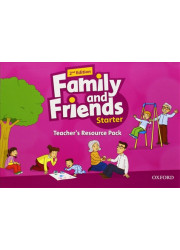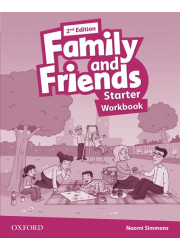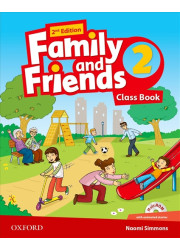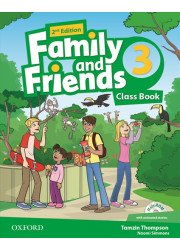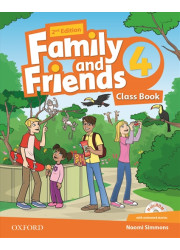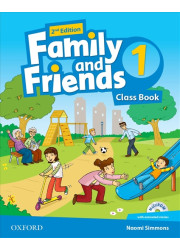
Family and Friends 2nd Edition Starter Class Book
Підручник з кодом доступу до онлайн ресурсів
Повернутися до серії: Family and Friends
| ISBN: | 9780194808354 |
| Автор: | Naomi Simmons |
| Видавництво: | Oxford University Press |
| Мова: | Англійська |
| Рівень CEFR / PTE: | Pre-A1 |
| Рік видавництва: | 2014 |
Плануєте замовляти підручники на групу чи клас?
Пропонуємо спростити процес оформлення великого замовлення до заповнення короткої форми.
New Family and Friends 2nd Edition combines brand-new fluency, culture, assessment, and digital resources with the features teachers love from the first edition; fast-paced language, strong skills training, unique phonics programme, civic education and comprehensive testing.
In the Class Book:
-
Words and grammar. New words are introduced in relation to each unit's topic or theme.They are presented in the Class Book with support from the flashcards and recordings and are then practised with chants, songs, and motivating classroom games and activities. The children are first exposed to the new grammar items alongside the key words in the unit stories. They then move on to focused grammar practice, which is reinforced with a range of spoken and written activities.
-
Skills. Each unit of Family and Friends 2nd Edition contains two pages dedicated to the development of reading, listening, speaking, and writing skills. The reading texts in this section expose children to a balance of both familiar and new language. With a range of different text types of increasing complexity, children develop the confidence to recognize and use the language they know in a wide range of situations. They develop the skills of reading and listening for gist and detail, both of which are essential for complete communicative competence. The writing skills section provides a complete course in English punctuation, syntax, and text structuring. The syllabus resembles that used with children who are native English speakers.
-
Phonics. Phonics teaches the relationship between letters/letter combinations and the sounds they make. The study of phonics enables children to decode new words, thereby improving reading skills and helping them to grasp spelling and pronunciation patterns quickly Family and Friends 2nd Edition draws on the principles of synthetic phonics, in which sounds and letters are combined to form whole words. Every unit of Family and Friends 2nd Edition contains a phonics lesson. In the first half of Level 1, the alphabet letters are reviewed with their most common sound values. Children see the relationship between the shapes of upper- and lower-case letters, the letter names, and the sounds they make. From midway through Level 1, children learn that letters can be combined to form new sounds. From Level 2 onwards, children learn to pronounce and spell common consonant blends at the beginning and ending of words and then see how vowels are combined to form long vowel sounds. By the end of Level 4, children will be able to identify and spell all of the most common sounds in the English language and recognize that many sounds can be spelled in different ways.
-
Stories. Every unit contains a story which provides a fun and motivating context in which the new language appears. In Levels 1 and 2 we meet a happy extended family and see the amusing adventures of Rosy, her cheeky two-year-old brother Billy, and their cousin Tim. The stories also provide ideal scenarios for practising and reviewing language structures and key words in a cyclical manner. Animated versions of these stories can be found on the Student MultiROM, Fluency DVD and iTools. They offer an effective way of presenting the story and target language in class, or can be used at home to consolidate what children learn in the first two lessons of each unit.
-
Songs and chants. Every unit in Family and Friends 2nd Edition contains a song for children to practise the new language, as well as vocabulary and phonics chants. Melody and rhythm are an essential aid to memory. By singing children are able to address fears and shyness and practise the language in a joyful way together. They are also fun and motivating activities and are a good opportunity to add movement to the lessons.
-
Drama and Total Physical Response (TPR). Students of any age, especially kinaesthetic learners, benefit from associating language with movement and actions. In Family and Friends 2nd Edition children are given the opportunity to act out the stories with simple drama activities. One of the main abstacles to language learning at any age is self-consciousness. Drama, by appealing to the imagination, is an excellent way for children to lose themselves' in the story, thereby increasing their communicative ability. Like other skills work, drama helps children to communicate and be understood. By developing performance skills, they practise and become luent in expressing real-life situations, starting with the story in the classroom and then moving on to real-world contexts.
-
Games and optional activities. Games provide a natural context for language practice and are very popular with children. They promote the development of wider cognitive skills such as memory, sequencing, motor skills, and deductive skills. If required, all the games in Family and Friends 2nd Edition can take place at the children's desks with a minimum of classroom disruption. Suggestions for optional activities are included in the teacher's notes. They can be used according to the timing and pace of the lesson and their appropriacy to the children in the class. Typically, optional activities in Lessons 1-4 are games and TPR activities that allow children to respond to the new vocabulary and sounds they are learning in a way that is fun and motivating.
-
Review units. After every three units there is a Review unit. These are shorter units of exercises which provide additional practice of the vocabulary and structures presented in the three preceding units. No new material is presented or practised in these units. They can be used as a progress test to check that children have remembered what they have learned.
-
The Student MultiROM contains: Listen at home target language, songs, and phonics chants for children to practise at home. They can be played on a CD player, or on a computer using the audio player. Computer-based interactive activities which practise the vocabulary, grammar, and phonics from each unit. Karaoke versions of the songs for children to sing along to. Animated stories for each of the 16 units in the Class Book.
1 710 грн.
200 грн. 2 131 грн.
313 грн.
725 грн.
725 грн.
725 грн.
725 грн.



